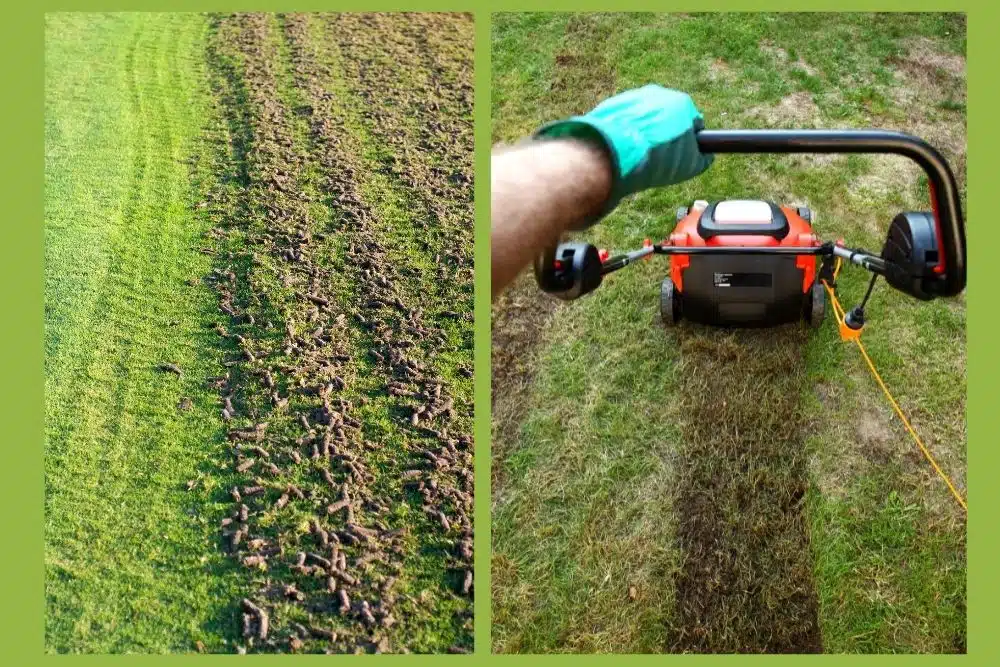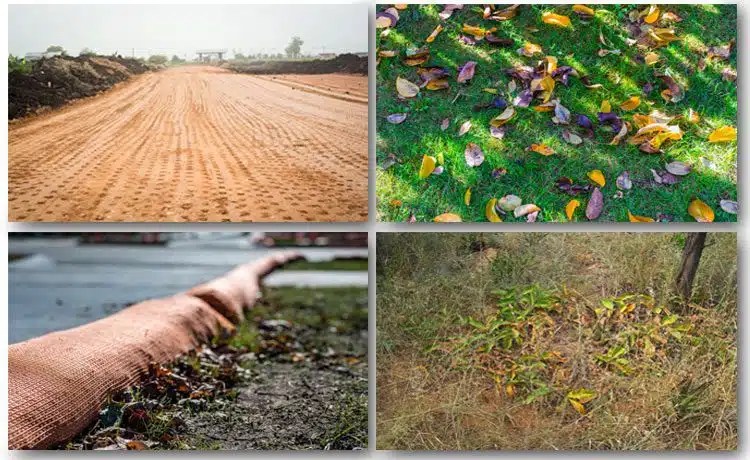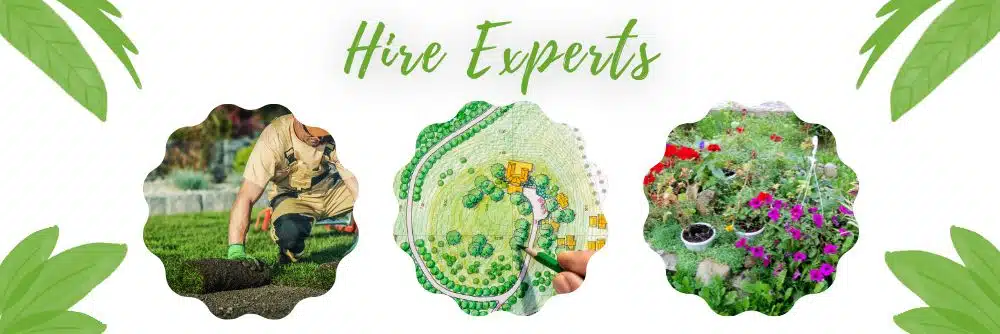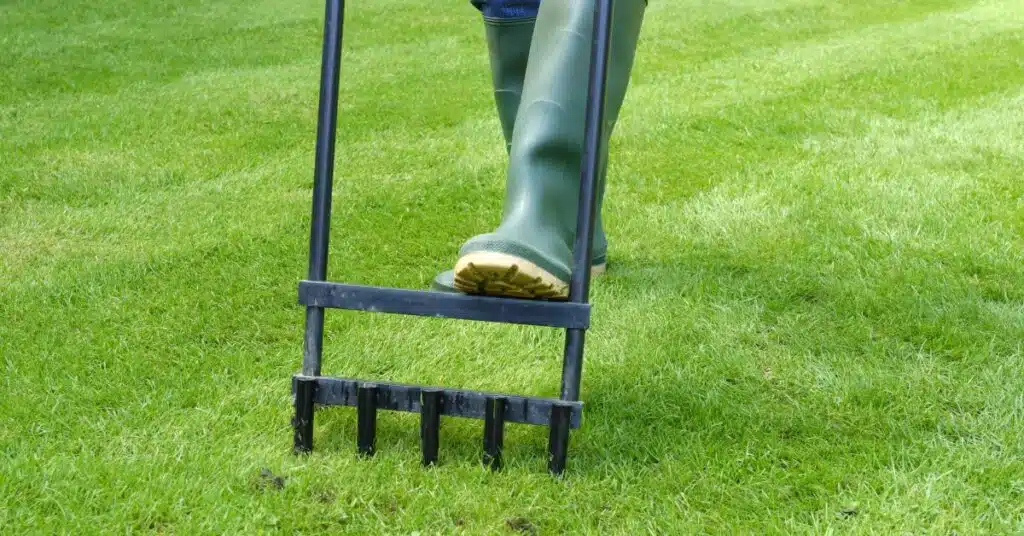❇️ INTRODUCTION
Maintaining a healthy and vibrant lawn is a challenging task. It requires dedication, persistence, a lot of research, and hard work. For a rich landscape and its proper maintenance, you need to take care of the soil. Soil health is of utmost importance when it comes to a healthy landscape. To amplify the resilience of your soil, you can opt for fertilizers, mowing, applying organic substances, mulch, and, most importantly, aeration. In this blog, MPR Landscapes will guide you thoroughly regarding the central concept of lawn aeration, its workings, and some tips on incorporating it into your landscape.
❇️ WHAT IS LAWN AERATION?
Lawn aeration refers to piercing the soil with small holes or minute punctures. These small holes or gaps allow air, water, and nutrients to flow easily into the soil. This penetration gives plant roots all the essential elements required for robust growth.
The term’ aeration’ means introducing and circulating air into a material or new medium. Lawn aeration allows not only air but also other elements into the soil. Plants demand a balanced composition of everything for optimal growth. Therefore, aeration is an ideal way to ensure your plants efficiently get all the nutrients and water.

Aeration offers a multitude of benefits for your landscape. For instance, it significantly enhances the growth and resilience of roots, leading to healthier and more robust plants. Vigorous plants and roots improve the overall appearance of your landscape. Similarly, your plants become more resistant to pest attacks and diseases.
❇️ ALL YOU NEED TO KNOW ABOUT SOIL COMPACTION AND THATCH
Before diving into the technical workings of lawn aeration, it is paramount to learn about soil compaction and thatch first. Compact soil is an increasingly dense, thick, and closely kneaded soil. It makes soil impenetrable by filling up any extra spaces within.
Compaction occurs owing to a multitude of factors. First and foremost, the soil is prone to become compact over time. Moreover, stress on the ground makes it denser. This extra stress comes from foot traffic, bulky construction machinery, lawnmowers, and occasional heavy rainfall.
The added stress significantly reduces the spaces of pores. Consequently, the air is displaced from the pores, considerably reducing the proper circulation of nutrients and air. This lack of nutrients or reduction thereof makes plant roots weaker over time. In this way, your plants and trees become vulnerable and more prone to pest attacks or diseases.
Thatch, on the other hand, is a layer of dead organic materials like fallen leaves, stems, algae, rotten grass, moss, and matter from fertilizers that accumulate on the soil surface. Irregular maintenance of your landscape is a significant factor that contributes to the development of thatch.
Whether thatch contributes to a healthy lawn or no depends on its thickness. A thin thatch layer is an insulation layer for your soil. It protects it from the extreme effects of temperature, heavy rainfall, and sunlight. It even aids in reducing water loss. Usually, a layer of less than half an inch is considered optimal for a healthy lawn.

A thick thatch layer, however, stops nutrients, air, and water from absorbing into the soil. Consequently, roots stay deprived of these essential elements leading to poor plant nourishment. Moreover, a thick layer becomes a breeding ground for pests, diseases, and mold. Another issue with thickness is that it inhibits products like fertilizers and pesticides from reaching the roots. Overall, soil compaction and thatch contribute to shallow root growth and subsequent plant death.
❇️ HOW DOES LAWN AERATION WORK?
To save you from all the troubles mentioned earlier, soil aeration is handy here. It alleviates soil compaction and improves your landscape’s appearance and overall health. Lawn aeration is performed using aerators apt for manual and motorized operations.
Aerators come in all shapes and sizes to make usage easy for consumers. They usually have spikes of varying sizes attached to them. They aid in puncturing the soil to create spaces for the circulation and absorption of nutrients. Aeration is not tricky, but you need to know its workings, mechanics, and complexities.
❇️ EXPLORING DIFFERENT TYPES OF LAWN AERATORS.
Let us have a look at the main types of aerators available in the market:
⭕ Hand Aerators
Hand aerators are all about manual operations. They require some effort to operate by hand. Their design includes an extended handle that allows convenient movements without getting close to the tines. Furthermore, the spikes are attached at the bottom part. Hand aerators are suitable for small-scale lawns. They are efficient for small areas, such as your backyard.
⭕ Spike Aerators
Spike aerators are among the most common aerators people use for their lawns. They are designed to be operated mechanically or manually, depending on the type you choose to buy. Manual ones require hands, whereas mechanical aerators are powered by electricity mostly.
Spike aerators often come in cylindrical shapes. The machine has prongs attached to it in clusters or rows. These spikes puncture the soil as your roll over the device on the ground. This type is efficient for small-scale lawns or backyards. It is a remedy for soils with mild compaction, as it does not technically remove soil. So spike aerators are good at providing short-term decompaction.
You can find cheap spike aerators online. They are convenient to use, thus rendering them decent choices that people prefer for their backyards. However, you need to take care of the amount of pressure you apply during aeration. The holes around spikes can accidentally increase soil compaction.
⭕ Plug Aerators
Plug aerators are considered one of the most effective methods of lawn aeration. Popularly known as core aerators, they are plugged directly into the soil. The process entails removing small plugs or cores from the ground. The created spaces circulate water and nutrients by allowing uncomplicated penetration. In addition, they give easy access to these elements to shallow and weak roots. In this manner, plug aerators help relieve the built-up pressure of compact soil and enhance drainage.
⭕ Shoe Aerators
Shoe aerators have spikes attached underneath the shoe surface. In this method, you have to walk around your lawn or backyard while wearing these shoes, and voila! Your landscape will be aerated. You can also create your DIY shoe aerators. However, this approach is unsuitable for a large area or heavily compacted soil.
⭕ Slicing Aerators
As the name suggests, slicing aerators are designed with sharp blades that cut into the soil. These blades slash the earth and create fine slits inside for aeration. They are usually mechanically operated.
⭕ Rolling Aerators
Rolling aerators have drum shapes with protruded spikes or tines. These blades create small holes as you move across the area of your lawn. Rolling aerators are cheap and easy to use but require much strength and muscle. The former proves to be less efficient if we compare rolling aerators to plug aerators. It is also important to note that these spikes are not designed for deep aeration treatments. If you have a small lawn and mild soil compaction, go for a rolling aerator! You get exercise and a good job done simultaneously.
⭕ Liquid Aerators
Liquid aerators do not require plugging or spikes plunging into the soil surface. Instead, they sprayed organic chemicals onto the soil to break the thatch layer. So there is no need to make small holes in the lawn. You can use a hose or a pump spray for this sort of aeration. Thinning the thatch layer allows nutrients and oxygen to reach plant roots adequately. T
here are several advantages of liquid aerators, such as:
- No need for plugs in your lawn soil. This is perhaps the reason for its popularity. It keeps your landscape’s appearance intact.
- The spraying of chemicals allows broader area coverage compared to manual aerators.
- Liquid aerators deliver long-lasting results by breaking the thatch layer and improving soil compaction.
You can use liquid aeration with other aerators for the best results. However, it is essential to note that do not overdo aeration. It can result in soil erosion, water run-off, overgrowth of weeds, and wastage of precious resources. Hence, it is crucial to follow proper guidelines for aeration. Soil compaction or vulnerability of your plants is not something you should be worried about! We are here to help you cope with this hassle. If you are afraid of the technicalities of aeration, leave all the hard work to professional landscapers like MPR Landscapes.
❇️ TIPS FOR INCORPORATING AERATION IN YOUR LAWN
Now that we have thoroughly discussed the different types of lawn aerators and their uses, let us move on to tips for lawn aeration.
⭕ Prepare Your Soil Beforehand
Make sure to prepare the soil of your lawn before aeration. Inspect your landscape first. Check its texture and water level. The soil should not be bone dry or extremely wet. Aeration will inefficiently break down dry soil and ruin its appearance alongside texture. The soil should be sufficiently moist only.
⭕ Choose The Right Type of Aerator
Now that you know the main types of aerators, pick the right one according to your soil demands, the area size, compaction level, and the resources you can spend on it. Choosing shoe or hand aerators is not wise if you have a large backyard to aerate. Instead, you can opt for liquid aeration. Similarly, if the soil compaction level is high, you can combine different aerators for maximum results. For example, liquid, plug, or spike aeration will be a good combo.
⭕ Be Careful Around Your Lawn Equipment!
You ought to be extra careful around the lawn apparatus. This equipment includes sprinklers, valves, and other tools fixed in your landscape. Most aerators with sharp spikes are likely to damage your devices permanently. A safe option is to mark your equipment after inspecting its places. For example, you can place small flags of vibrant colors next to the apparatus.
⭕ Water Lawn Afterwards
An excellent way to finish off the aeration process is by watering the lawn afterward. Watering helps the nutrients to get better absorbed into the soil. It amplifies the effect of aeration. But refrain from overwatering as it can limit the impact of aeration or render it useless for your landscape by overfilling up the small holes. You can always consult a professional landscaping company to determine the dos and don’ts of aeration.
⭕ Rake Through Thatch
Rake is a common outside tool with fine tines. It is used to remove debris or organic matter from lawn surfaces. Raking is used in regular maintenance schedules to prevent the build-up of excessive matter that can potentially harm your landscape. It removes dead grass, stones, and accumulated leaves that cover the surface area of soil and prevent the absorption of essential nutrients, water, and sunlight.
Similarly, gentle raking removes excess thatch. Thatch rakes are different from the usual garden rakes. The former has curved steel tines that easily penetrate the soil. Refrain from rushing or being aggressive when it comes to raking. It can damage your soil surface and grass. Instead, ensure you thoroughly and evenly cover all of the areas. Once you are done cleaning, pile up the thatch and all the organic matter to make compost or mulch.
If the thatch layer is too thick, it will likely be challenging to remove it only with raking. So practice raking before aerators to achieve better overall results.
⭕ Avoid Frequent Aeration
As good as aeration sounds with its multiple advantages, overdoing it can be a hazard for your lawn. Consider several factors before determining the aeration schedules, such as soil type, compaction, and thatch thickness. Usually, aeration is recommended once or twice a year for ideal results. This is because the optimal seasons for aeration are spring and fall, the growing seasons for grass. However, if you see issues with your lawn, you can go for more frequent aeration.
⭕ Hire Professional Landscapers!

Hiring professional landscapers can always go right! Experts like MPR Landscapes consider essential factors like soil type and its needs. Then we determine the best course of action to remedy the issue. We have the three essential E’s: experience, expertise, and equipment. You do not need to worry about doing hectic aeration jobs at all. Hire us to avail yourself of our services!
❇️ CONCLUSION
Lawn aeration is essential for your lawn’s vitality, health, and resilience. It makes the roots stronger and plants resistant to diseases. In addition, aeration helps in resolving issues like soil compaction and thatch build-up. Moreover, you can choose the correct aerator from various available varieties. Decide whether you only require hand aerators for a small backyard or plug aerators for a more technical approach. Whatever your needs be, MPR Landscapes can aid in fulfilling them with the highest level of customer satisfaction. Contact us today for further inquiries!

